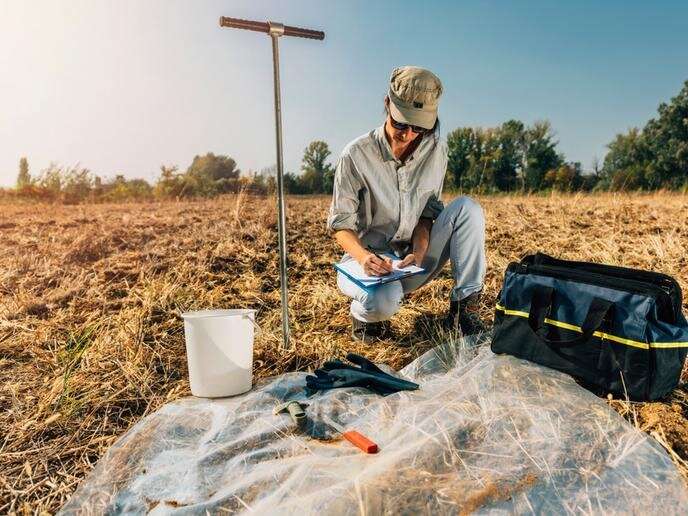Does an ally against climate change lie beneath our feet?

By enhancing soil's ability to store carbon, the ground we walk on could play an essential role in keeping carbon dioxide out of the air.
If we're going to fight the effects of climate change, we're going to have to get our hands dirty.
"With a huge potential to act as a carbon sink, the soil that sits right under our feet could be at the front lines of climate change," said Dr. Dragutin Protic, CEO of GILab, a company dedicated to developing solutions based on ICT and geoinformatics.
A carbon sink is a reservoir capable of accumulating and storing carbon for an indefinite period. In doing so, it lowers the concentration of carbon dioxide (CO2) from the atmosphere.
According to Dr. Protic, who cited some recent scientific research, soil has the potential to remove an estimated 1.09 gigatonnes of CO2 per year.
From carbon sink to carbon emitter
Even though soil carbon sequestration appears to be a natural, no-regret solution to mitigating climate change, after decades of poor land management, Europe's soils have been significantly degraded. "Soil degradation leads to a reduction in soil organic matter (SOM), which is where carbon is stored," explained Dr. Protic. "In fact, according to recently published scientific research, nearly half of EU soils now have less than 2 percent SOM."
As a result, instead of capturing carbon, soil is releasing carbon into the air, setting the scene for a climate catastrophe.
"Europe's croplands are losing carbon at a rate of 0.5 percent per year," warned Jean-Francois Soussana, a researcher and vice-chair at INRAE, (France's National Research Institute for Agriculture, Food and Environment), and a member of the Mission Board on Soil Health and Food. "The picture is even more dire for peatlands which, as they are being rapidly drained, release huge amounts of carbon into the atmosphere."
In an effort to reverse this trend, both Dr. Protic and Soussana are leading efforts to preserve and enhance soil's carbon sequestration capabilities. "Increasing carbon sequestration in soil enhances its resilience to the rapidly changing climate," said Soussana. "It also improves the quality and fertility of agricultural soils, as well as contributing to food security."
Empowering soil sequestration smart farmers
As both researchers point out, storing carbon in soil organic matter requires healthy plants, high-quality soils and, most importantly, smart farmers. "It seems crucial to empower farmers and other stakeholders through effective knowledge creation and sharing," remarked Soussana.
One initiative helping to facilitate this knowledge exchange is the AgriCapture project. Led by Dr. Protic, the project is developing a platform that uses Earth Observation to help farmers and public authorities explore opportunities in regenerative agriculture—a method of producing food that has a positive impact on the environment.
Earth Observation uses remote sensing technologies, such as the EU's Copernicus satellite system, along with various ground-based techniques, to gather information about the Earth's physical, chemical and biological systems. Using this data, the platform will map soil carbon and monitor soil carbon sequestration across Europe.
"This will allow farmers to visually see how implementing regenerative agriculture practices could increase both carbon sequestration and farm profitability," explained Dr. Protic. "It will also allow farmers to monitor their carbon release/capture ratio to ensure that all carbon offsetting goals are being met."
The AgriCapture project is also working to verify and support the implementation of regenerative agricultural practices that, if successful, would result in the certification and generation of 'carbon credits."
"Considering soil's significant potential to act as a carbon sink, regenerative agriculture is a powerful tool for mitigating climate change," said Dr. Protic.
Putting farmers at the vanguard of carbon sequestration
Another initiative using data to drive soil carbon sequestration is CIRCASA. Led by INRAE, the initiative is working to build an integrated soil carbon balance monitoring system and foster international research cooperation on soil carbon.
According to Dr. Soussana, who leads the initiative, by bringing together data from satellites, soil surveys, long-term experiments and CO2 flux measurements, the system will empower farmers to be at the vanguard of soil carbon sequestration.
Beyond simply enabling farmers to monitor soil organic carbon, Soussana says the system can help teach us to create healthy soil by supporting nature-based carbon sequestration. "By ensuring that farmers know exactly how much carbon is being stored in their soil, they will be well positioned to make informed decisions that will lead to both healthy yields and a healthy planet," said Dr. Soussana.
Rehabilitating the carbon sink
Through initiatives like AgriCapture and CIRCASA, Dr. Soussana is confident that Europe will be able to enhance its soils' carbon sequestration levels, thus ensuring that soil remains a carbon sink and not a carbon emitter.
"We really do not have a choice, and we have to act now," stated Soussana. "Without carbon sequestration and the conservation of soils, I don't see a viable route to staying within the +2°C by 2030 as proposed by the Paris Climate Agreement or to achieving the ambitious goals of the European Green Deal."
Laying the foundation for a common EU framework to preserve, protect and restore soil, the Commission is adopting a new Soil Strategy this year.Tropical forest soils capture carbon under elevated nitrogen deposition
More information: New Soil Strategy: ec.europa.eu/environment/news/ … rategy-2021-02-02_en
Provided by Horizon: The EU Research & Innovation Magazine
No comments:
Post a Comment